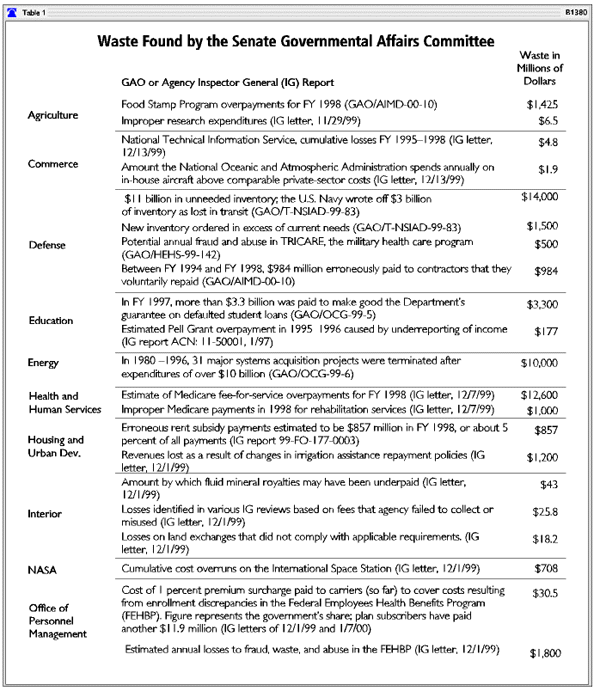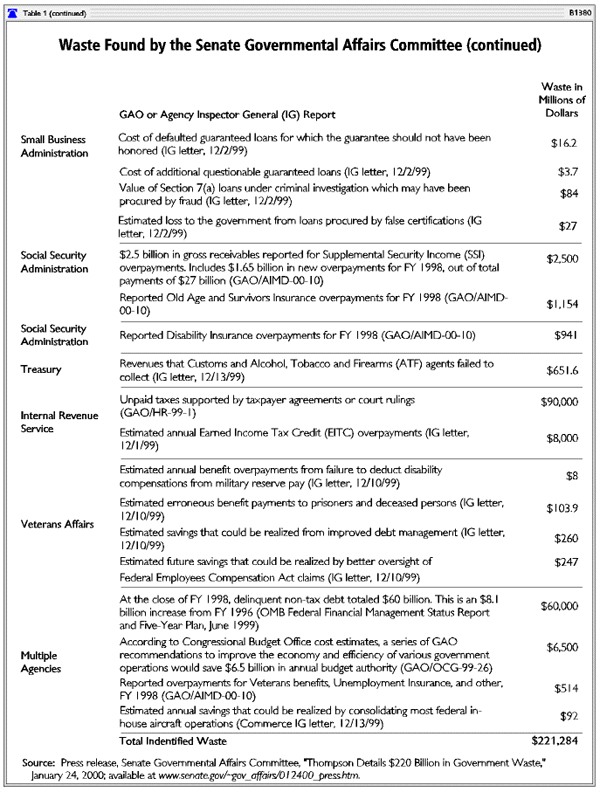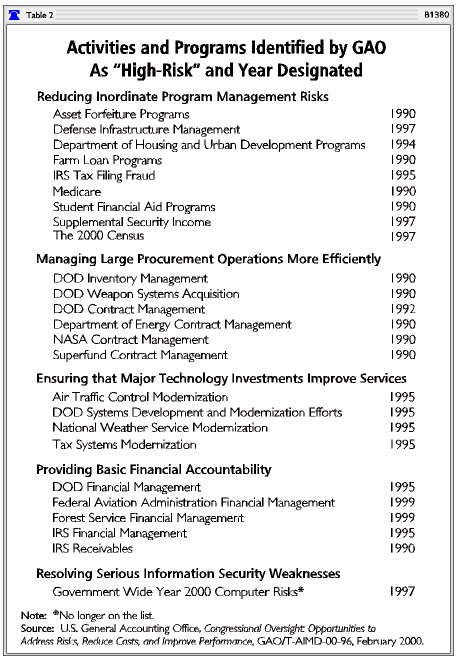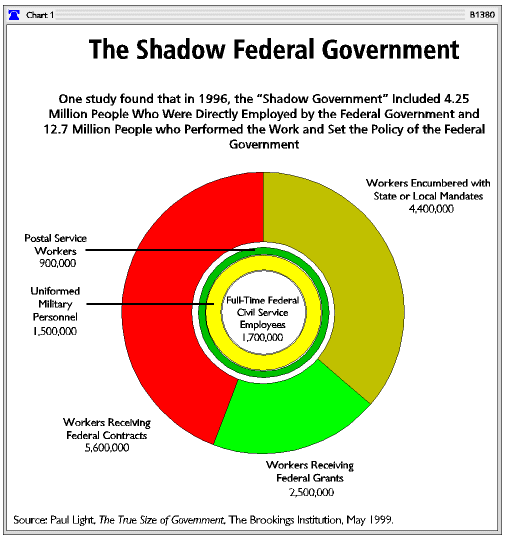Opinion polls consistently show low levels of public trust and confidence in the federal government. These low expectations of federal performance reflect the widespread belief that Washington is wasting a high proportion of the tax dollars Americans pay each year. In 1998, a survey conducted by the Washington-based Pew Research Center found that 64 percent of Americans view the government--with a burgeoning budget of $1.8 trillion--as "inefficient and wasteful," while only 48 percent believe that it is "run for the benefit of all people."2 It is understandable that taxpayers expect the federal government to use their money wisely, minimizing waste, inefficiency, and mismanagement. Yet Washington seems to have set its course on automatic pilot. It continues to create new programs and new spending without regard for how well current programs are doing. Few federal agencies consistently document what their programs are accomplishing to provide Congress and the American public with credible and objective evaluations of their performance.
The 103rd Congress sought to correct this problem when it passed--and President Bill Clinton signed--the Government Performance and Results Act in 1993. This law has become the centerpiece of a new effort in Congress to make federal program management, decision-making, and accountability even more performance-based. Efforts to truly "reinvent" the way Washington works will require an nonpartisan framework for implementing commonsense government reforms. Congress and the Administration will need credible performance information, objective program evaluations, and other sound reviews of existing federal programs before they can make the sorts of changes that are needed to improve federal performance and regain the confidence of the American people.
The act's power lies in its focus on measuring the effectiveness of all existing federal programs and providing Congress with that information in order to determine whether the agencies are achieving the intended results. As Senator Ted Stevens (R-AK) explained at a hearing in June 1997:
If properly implemented, the Results Act will assist Congress in identifying and eliminating duplicative or ineffective programs. We intend to monitor compliance with the Results Act at every step of the way to ensure that agencies are providing us with the information necessary to do our job, spending the taxpayers' money more wisely.3
For example, the growing federal entitlements consume approximately 52.7 percent of the federal budget today, compared with 26.1 percent in 1962. Although all federal spending has increased, the percentage of funding for the discretionary portions of the budget has decreased: While 67.5 percent of the budget was spent on discretionary accounts in 1962, the latest figures show discretionary spending consuming less than 34 percent--a significant squeeze that is redistributing Washington's escalating resources. Meanwhile, interest on the national debt during this same time period has increased from 6.4 percent to 13.5 percent ($220 trillion in 1999).4
The Results Act's effectiveness will depend on the willingness of Congress to engage agency officials in regular dialogue, to ask results-oriented questions at meetings or hearings, and to include the information on performance they gain from these interactions in their decisions about reauthorization, appropriations, and oversight. But even with the requirements of the Results Act, Congress may still need to demand that federal agencies provide credible, accurate, and objective information on their performance. If need be, it should seek assistance from agency inspectors general (IGs), the U.S. General Accounting Office (GAO), the Congressional Research Service (CRS), other external auditors, and its own investigators.
-
A December 1998 CRS report showed an increased use of performance measures, particularly by appropriators during the 104th and 105th Congresses. During the 105th Congress, the CRS found 45 public laws and 78 reports accompanying bills that referenced performance measures or the Results Act. This compared with 14 public laws and 27 reports during the 104th Congress.5
-
In June 2000, the Senate Appropriations Committee is publishing a Special Report on the Results Act that will present the findings of an evaluation of major agency compliance with the act and implications for the appropriations process.
-
On March 10, 1999, Representative Dan Burton (R-IN), chairman of the House Government Oversight Committee, and Representative C.W. "Bill" Young (R-FL), chairman of the House Appropriations Committee, wrote to the 24 agencies covered by the Chief Financial Officers Act, threatening to cut their funds if they did not improve agency performance, particularly on major management problems.6
-
On March 31, 2000, Senator Fred Thompson (R-TN), chairman of the Senate Governmental Affairs Committee, asked the GAO, the CRS, and the agency inspectors general to review key policy objectives of the same 24 federal agencies to assess their performance with results that matter to the American people. For the first time in the Results Act's history, this comprehensive request will focus agencies and Congress on the government's policies rather than on technical compliance or process-oriented goals.7
- Since 1997, to assist in its efforts to hold federal agencies accountable, Congress has asked the GAO to produce over 200 reports, testimony, or products related to the Results Act.
As the GAO reports show, dozens of programs in various agencies may be directed at the same problem. As former Comptroller General Charles Bowsher stated in testimony before the Senate Governmental Affairs Committee in 1995:
David Walker, the current Comptroller General, reiterated the problems of duplication and fragmentation in recent testimony before the Senate Budget Committee:The case for reorganizing the federal government is an easy one to make. Many departments and agencies were created in a different time and in response to problems very different from today's. Many have accumulated responsibilities beyond their original purposes. As new challenges arose or new needs were identified, new programs and responsibilities were added to departments and agencies with insufficient regard to their effects on the overall delivery of services to the public.8
Walker cited a number of familiar examples, such as the 13 different federal agencies that administer over 35 different food safety laws and the eight agencies that administer 17 differentVirtually all of the results that the federal government strives to achieve require the concerted and coordinated efforts of two or more federal agencies. Yet our work has repeatedly shown that mission fragmentation and program overlap are widespread and that crosscutting federal program efforts are not well coordinated. In program area after program area, we have found that unfocused and uncoordinated crosscutting programs waste scarce resources, confuse and frustrate taxpayers and program beneficiaries, and limit overall program effectiveness.9
programs dealing with rural water and wastewater systems.10 Other examples noted by the GAO include 50 programs for the homeless administered by eight agencies11 and hundreds of programs aimed at low-income urban communities. Regarding the urban programs, the GAO reported in 1995 that:
The federal government assists distressed urban communities and their residents through a complex system involving at least 12 federal departments and agencies. Together, these agencies administer hundreds of programs in the areas of housing, economic development, and social services. For example, we reported that there are at least 154 employment and training assistance programs, 59 programs that could be used for preventing substance abuse, and over 90 early childhood development programs. Considered individually, many of these categorical programs make sense. But together, they often work against the purposes for which they were established, according to the National Performance Review report.12
As the GAO indicates, these federal services are representative of many other problems, including:
Last November, Senator Fred Thompson identified $19.1 billion in improper payments to ineligible beneficiaries from large federal social programs. As Table 1 shows, his committee
documented over $220 billion of wasteful federal spending, including $984 million in defense overpayments to contractors who voluntarily returned the funds over a five-year period.15
A similar pattern is found in the reports of agency inspectors general. In each of the past three years, the IGs of major federal agencies reported to Congress the most serious performance problems they faced. Like the GAO high-risk areas, the problems identified by the IGs remain much the same year after year.17
The GAO and IG reports point to several recurring root causes of these problems,18 including the fact that most federal agencies suffer from one or more core weaknesses that would undermine the ability of any organization, whether public or private, to succeed. These weaknesses include:
The stated objectives of the National Partnership for Reinvention (NPR)--a project to "reinvent government" espoused by Vice President Al Gore--are laudable. However, specific NPR projects at best merely tinker at the margins of the government's most serious performance challenges. The GAO has been unable to verify the claimed cost savings or programmatic reform from this initial effort.19
Little direct correlation exists between NPR projects and the "high-risk" or other mission-critical problems highlighted by the GAO and agency IGs. Indeed, the NPR's efforts often are counterproductive. Efforts to "downsize" the federal workforce, for example, occurred randomly rather than strategically, with no effort to make a distinction between essential and unnecessary employees. The indiscriminate downsizing that followed actually exacerbated many of the core performance problems within each agency.While the direct federal payroll has been reduced under the Clinton Administration, most of the cuts have come from the Department of Defense budget and have more to do with the end of the Cold War than with the NPR. Also, many former federal jobs have migrated to a "shadow" federal workforce consisting of contractors, state and local employees, and private-sector employees who spend valuable time carrying out the federal mandates (see Chart 1). For example, the Department of Education may show a 6 percent reduction in federal civil servants, but it experienced at the same time a 129 percent increase in the number of contract workers.20 Considering all those working to carry out federal mandates, the number of people employed by the "shadow" federal government is actually much larger than the number on the federal government's direct payroll.


To date, Congress has done a relatively poor job of forcing agencies to improve their efficiency and cut waste. One reason for this mediocre performance is that the annual appropriations process itself is inefficient and consumes huge amounts of time and effort.22 It is virtually impossible for Congress to enact the 13 regular appropriations bills by the start of each new fiscal year.
Consequently, the usual finale to the appropriations cycle is a massive omnibus bill pulled together at the end of each session after intensive 11th-hour negotiations. These negotiations typically involve very few participants and take place out of the public eye. Most Members of Congress have only the vaguest idea of what they are voting on when they approve the omnibus bill. Following its enactment, it can often take weeks to sort out what is included in the spending bills. This end-of-session process is so intensive and exhausting that mistakes are inevitable and the participants are left feeling like victims.
One reason for the breakdown in the appropriations process is the increasing burden of substantive legislative provisions that can be enacted only as part of "must pass" spending bills. This problem stems from the inability of Congress to enact authorizing legislation for many spending programs during the regular course of business.The Congressional Budget Office recently reported that Congress had enacted about $121 billion in FY 2000 spending for programs whose authorization had already expired.23 This included about $8.2 billion in funding for foreign aid programs that were last authorized in 1987 and $4.4 billion for Department of Energy programs last authorized in 1984. The CBO report does not take into account funding for programs that never were authorized. Appropriating funds for unauthorized programs violates both House and Senate rules, yet these rules are routinely waived as a way to garner necessary votes to pass critical legislation. Controversial reauthorization efforts are not likely to be passed if slim margins exist between the two parties.

It should be noted that some congressional committees provide valuable feedback to agencies on their performance information, and this feedback has encouraged an improved policy debate between Capitol Hill and the agencies. These committees include the Senate's Governmental Affairs and Appropriations Committees and the House's Education and Workforce, Science, Transportation, and Veterans Affairs Committees.[F]rom career bureaucrats to Cabinet Secretaries, nearly everyone in the Executive branch knows that when they're asked to come up to the Hill for an oversight hearing, once it's over, it's over--rarely do they have to worry about any follow-up hearings because Congress just doesn't have the time.24

Any new orientation for government, however, must rest on a foundation of objective and credible performance data that enable Congress, the President, and the American public to see what is being accomplished with the tax dollars collected. Yet, in a significant warning to Congress and the agency offices of inspectors general, the GAO recently said that 20 of 24 major agencies are incapable of providing credible performance data on the objectives they are trying to achieve.25
After months of denying a problem and under pressure from Congress, the media, and the GAO, the LSC reported in September 1999 that in 1998 it closed only 1.1 million cases--about 360,000 fewer than it reported closed in 1997. This is the lowest recorded and reported closed case-count total in the history of the agency. The lower number translates into a $465 average cost per case, which is the highest cost of federal aid to the poor in the history of the program.26
Good information, on the other hand, can result in tangible improvements in the way government delivers its services. For example:
- Using the Veterans Health Administration (VHA) database, veterans' hospitals began to compare their own performance with other hospitals. Based on the various success rates for cardiac surgeries, the VHA made changes in how it conducted diagnostic testing to handle post-operative procedures. According to the GAO, the VHA found that the performance data showed that cardiac teams had lowered their mortality rates between 1988 and 1996 by an average of 13 percent.27
- When towing industry data for 1982 through 1991 showed that 62 percent of marine casualties were due to human error, the U.S. Coast Guard realigned its marine safety program away from inspections (outputs) and toward efforts to reduce casualties (outcomes). This joint effort between the Coast Guard and the shipping and towing industry, which began in 1994, brought about a decline in the fatality rate--from 91 per 100,000 employees in 1991 to 27 per 100,000 employees in 1995. The program not only improved the Coast Guard's effectiveness, but did so with fewer people and at a lower cost.28
- Manage for results by focusing agency performance and accountability requirements on key outcomes. Selecting appropriate measurements of performance, obtaining credible data, and using those data to make decisions are activities that should occur with greater regularity within the federal government. Some agencies are driving over 900 measures through their systems to comply with the Results Act. The law would work better if fewer, more manageable numbers of measures were used on priority programs.
- Link funding to performance results by attaching consequences to good and bad performance. The Administration, the OMB, and the agencies must tie funding of specific programs to performance in their budget formulations. Agencies and programs that pursue and achieve important results should be rewarded in financial and non-financial ways, including public recognition. Those that do not achieve good results should be fixed or eliminated.
- Link related program actions to performance results. More needs to be done to coordinate and rationalize the myriad overlapping or duplicative programs that now exist. New interagency coordination teams should share valuable performance measures and data, using the same performance measures to determine which programs are working and which are not. It is particularly important that Administration proposals for new or revised programs identify the intended results and point out how the programs relate to similar existing programs.
- Subject administrative regulations to the same performance scrutiny and accountability that apply to programs and activities. Regulations should incorporate specific outcome-oriented performance goals and measures to the extent possible.
- Resolve mission-critical management problems that could undermine the capacity of agencies to achieve results. Many of the recurring performance problems stem from a lack of sustained commitment to resolve them. Experience demonstrates that an effective way to focus accountability on problems is for agency heads to adopt specific and measurable performance goals to address those problems.
- Suggest legislation to promote pay-for-performance in the federal civil service. Innovations are needed in the federal pay system that transform the inflexible pay and bonus systems into a more merit-based system with incentives that reward managers for achieving program outcomes. Incentive bonus programs need to be flexible enough to reward top performers and innovations in the federal government.
- Require agency heads to form performance-based organizations (PBOs). These PBO units have a competitively hired chief operating officer who commits to annual performance agreements and agrees to tie a share of his or her pay to the organization's performance. (Nine agencies are already structured this way.) The chief operating officers have broad latitude to design reward systems and management processes that meet their agency's needs. Pay adjustments are based on performance. Bonuses are available for superior individual or group accomplishments, documented productivity gains, or sustained superior performance.
- Expand performance-based contracting. Performance-based contracting should be the rule rather than the exception in the federal government. Federal contractors should be held to a higher standard for achieving results; payment should be withheld until contract performance is met. Awarding contracts for noble purposes but without follow-up that ensures that quality service has been delivered should end. Stricter contracts and better monitoring to assure accountability are necessary; otherwise, the people who should benefit from the program will suffer.
- Conduct comprehensive, systematic reviews of the stated goals of agencies within committee jurisdictions. Regular bipartisan and systematic oversight of what the federal agencies are accomplishing and how performance could be improved should be conducted by each House and Senate committee. Agency performance plans and reports submitted according to the Results Act should be used in this effort because they can promote more informed policy discussions and debates. Too often, Congress considers its job done once programs are enacted by law. Before passing authorizing or reauthorizing legislation, committees should be able to fully appreciate what past federal allocations have accomplished. Committee members should monitor the rulemaking and enforcement stages of the laws they pass by holding more hearings, having more briefings, commissioning better GAO studies, or working with the agency IGs. The information gained should be used to identify whether the private sector or the state or local government is in a better position than the federal government to accomplish the stated goal.
- Enact authorizing legislation for spending programs. Congress regularly ignores its own rules and approves hundreds of billions of dollars in unauthorized spending each year. Congress should enforce its rules that prohibit the consideration of appropriations for unauthorized programs. If the votes to authorize a program through the normal legislative process are not certain, the program should not be funded.
- Incorporate specific performance goals and measures in authorizing legislation. Congress should adopt rules prohibiting the consideration of significant program authorization or reauthorization legislation unless that legislation incorporates specific performance goals and measures. Congress should insist that the Administration address these issues as well when it submits a new budget or program proposals.
- Incorporate regular program evaluations into key spending priorities. Congress has been reluctant and often even negligent in demanding sound studies of program effectiveness from agencies. These evaluations should consume an increasing portion of the GAO's workload or should be contracted out to independent accountability professionals.
- Enact appropriations bills on a timely basis that provide funding based on proven performance. Congress should start enforcing the "regular order" through which decisions on individual appropriations bills are openly and knowingly made. It should also practice "truth in budgeting" by abandoning accounting gimmicks that often make a mockery of the appropriations process.
- Consider adopting a biennial budget. Sentiment is growing that the only way to effect fundamental reform of the appropriations process is by moving to a biennial budget cycle. A biennial process would have the added benefit of freeing more time for Congress to improve oversight of the federal bureaucracy. Regardless of the budget process timeline, Congress and the executive branch must have the will to make the funding decisions in a more timely and appropriate way.
If Congress and the Administration continue to seek Results Act reports from federal agencies and ensure, with help from the offices of inspectors general and the GAO, that the performance information they provide is credible and objective, the American pubic will be better able to identify which techniques of lawmaking--regulations, tax incentives, subsidies, grants, partnerships, or education campaigns--are most effective. Ineffective efforts could be fixed or eliminated.
Yet performance-based data will be useless unless Congress brings this information alive in oversight hearings, floor debates, or changes in authorizing or spending legislation. A results-oriented approach that adheres to the principles of accountability and performance results could lead to a smaller, smarter, more commonsense federal government that is truly worthy of Americans' trust as well as their hard-earned tax dollars.
Virginia L. Thomas is Senior Fellow in Government Studies at The Heritage Foundation.